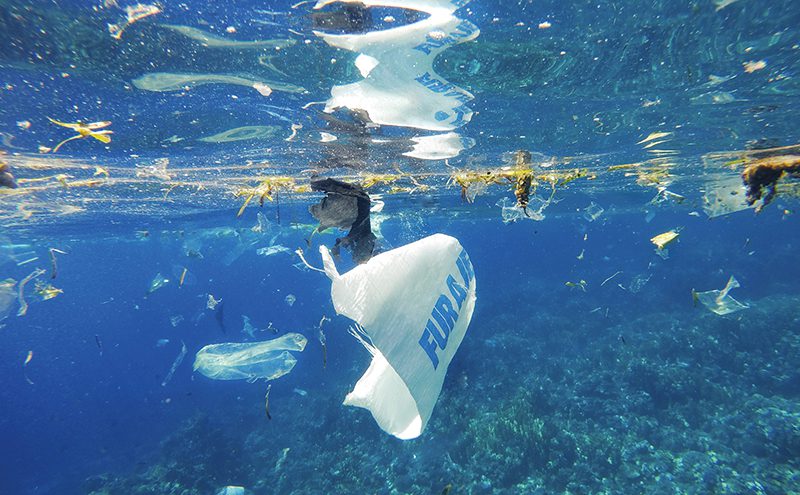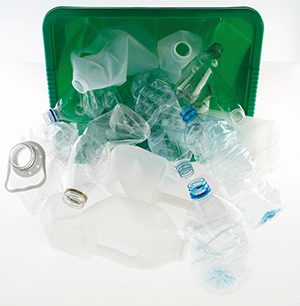It’s the bête noire of circular economy advocates: Plastic. Very little of it gets recycled or recovered, a problem variously attributed to consumer laziness, inconsistent collection systems, complex product design and the limitations of the materials. Is there any hope for the future? Or should we just stop using the stuff? And what will the UK do with all the recyclate China will soon be turning back? Envirotec reports on a recent panel debate

An obvious issue is the confusion many consumers feel with plastic recycling systems, and the lack of consistency between local authorities’ collection methods. In October 2016 WRAP published a set of Recycling
Guidelines, offering a vision whereby all local authorities and householders will have a consistent set of materials to recycle, a consistent method of collecting them, and a consistent message throughout the supply chain. Or at least that’s the intention. During a panel debate at the RWM show in September, Bernard Chase of WRAP conceded that “it’s not going to happen overnight” but recommended everyone take a look at the framework details on his group’s website.
Dan Cooke, director of regulatory affairs at Viridor, thought WRAP’s charter “was a great step in the right direction”, but unfortunately the industry isn’t starting from a blank page. Local authorities have arrangements with contractors that have been developed over decades, “so to turn that round is going to take a decade or so.”
More consumer education, and more incentive for people “to put the right stuff in the right bin”, were useful, but he also cited important progress being made with design-for-recyclability. Some of the leading retailers, he said, are making very clear statements that they will be working towards a single polymer for all their packaging, whether it’s a pot, tub, tray or bottle. The manufacturers and retailers need to look at packaging materials, to substitute in polymers with more recyclable properties or even short-cycle carbon materials amenable to energy recovery.
Iain Ferguson, environment manager with The Co-operative, said his group had been working to align the packaging it uses with “what the waste management industry tell us they want us to use”. This meant initiatives like narrowing the range of polymer materials and decreasing the complexity of packaging. As an example, he cited the Co-op’s recent move to single-polymer (PET) meat trays.
Sarah Ottoway, National Recycling manager, Suez Recycling & Recovery UK, felt the range of polymers in packaging made it difficult to create neat categories, and to have consistency – one retailer’s meat tray might use a different polymer from another. The profusion of different terms also contributes to the inconsistency. When you look at plastics as a whole, there’s two main streams: plastic bottles and mixed plastics. Even just the term “mixed plastics” is used interchangeably with many others – off the top of her head she cited “household plastic packaging”, “other plastics”, and “pots, tubs and trays”. And this creates confusion for people, when it comes to recycling.
Is it confusion or unwillingness? Referring to the classic plastic bottle, Paul East, a packaging technologist with plastics recycling group Recoup, said: “Everyone knows that’s recyclable, I think – yet still only 60% get recycled.” The challenge is to convince the public who don’t currently put their bottles in recycling that they should.
Who might fund the education of the consumer? Ottoway felt there was a lot of mileage in the example set by AluPro, the metal packaging industry group, whose Metal Matters campaign can be selectively rolled out in particular catchments, part funded between industry and either the local authority or the contractors. Suez worked with the campaign in Warwick a couple of years ago, she said, “and it worked incredibly effectively, and I think there’s a real call for something similar in plastics to get a consistent message out to householders”.
Ferguson said the Co-op were also keen to champion labelling. For example, the “Widely Recycled” label – co-designed by WRAP and The Co-op – can be used to align what local authorities ask their residents to do with what retailers put on the pack. “[Local authorities] could then say to their residents ‘we accept pots, tubs and trays, and we’ll accept it as long as it says “Widely recycled” on the pack’.” This makes it all quite simple, he felt. Retailers are good at putting recycling labels on; brand manufacturers not so much.
Finding a market for secondary plastics
It’s all very well being able to collect end-of-life plastics but without a market for the resulting material, it isn’t going to be recycled, said Chase. “I see plenty of sticks that are driving collection – both fiscal and [in terms of] compliance – and I see absolutely zero to balance the equation on the end markets”. There is a danger in leaving it to the free market, which at the moment seems to be saying ‘I’d rather use virgin polymer’.
“Everyone has a part to play,” suggested Ottoway. Brands and retailers had “a part to play to say ‘hang on, we can design-in recyclability and recycled content’” while consumers also had a part.
“There is no one body or person, or sector responsible for this,” said Cooke. “But governments also have to look at what mechanisms they can use to help create markets.” Possibilities included “better and smarter use of extended producer responsibility”. It already applies to packaging but you could look at ways of making it “more subtle”, to “provide real drivers to help create some of the embryonic markets that we are serving”.
 China: Big trouble?
China: Big trouble?
The question of end markets is all the more urgent with China’s recent decision to restrict imports of recovered materials unless they reach a contamination level of 0.3%.
China has at times taken about 60% of all the plastics the UK has collected for recycling, said Chase. A new destination will have to be found quickly, or else some way of taking this capacity within our own borders, a difficult possibility to foresee in the immediate term.
How long might it take to come up with alternative markets? “The short answer is quite a while,” said Chase. He felt the situation presented an opportunity “to have a root and branch look at the way we as a nation measure our recycling success”. At the moment we measure it by the weight of material collected – collection targets rather than recycling targets. It might make more sense to adopt a metric that gave some sense of the outputs rather than the inputs of the recycling process.
Cooke lamented China’s decision but said the UK recycling industry now had to step up to the mark and improve quality, and minimise the amount exported as well.
Governments could help. The forthcoming Waste and Resources Strategy could raise recycling targets, and potentially materials-specific targets to pinpoint waste streams especially impacted by China’s decision – like plastic.
Safeguarding quality
How might the recycling industry protect material quality?
Ferguson and Cooke both felt it was partly about continuing to plug the right message to consumers, to put the right stuff in the right bin. But Cooke said there was also a need for investment in better technology. At the moment, it was really difficult to make a business case for investing in a new MRF or polymers recycling facility “because of the market volatility and because of the short term contracts that many retailers and packaging producers want to enter into”.
Much of the technology used to recycle consumer dry-mixed recyclables in the UK is outdated too. It has “moved on in leaps and bounds in the last five or 10 years”, he said – referring to optical sorting systems and the like – “but it needs to get better”.
Viridor is starting to look at installing trial robotics lines “so instead of hand-picking and quality controlling some of our recycling lines [manually], if we can make robots do that much quicker, more effectively” then that will have repercussions throughout the supply chain, and more post-consumer waste will get recycled.
Black plastic blues
One well-known challenge for recyclers is black plastic packaging – specifically, that using carbon black – which goes undetected by NRI optical sorting equipment. Black denotes quality to the consumer, and is also useful for covering up unsightly bits of product. But white can do that too. More importantly there needs to be research into black materials that could use other pigments than carbon black. Viridor is working with the likes of Recoup and the Co-op along these lines.
Would biodegradeable plastics support greater recycling levels? Ferguson suggested they have a role to play with pieces of packaging that are never going to be recycled, like the labels on pieces of fruit. But it does need some sort of system to be worked out, so that if they end up in the food waste collection system – the best disposal route for them – then they are obvious and someone doesn’t have to go in and check if it’s compostable, and it doesn’t mean some collections intended for composting end up in landfill. “I think it can easily be done,” he said.
Will bioplastics have a role to play in food packaging? Cooke said there some exciting new plastics appearing on the horizon, such as polyethylene furanoate (PEF), which are made from plant-based materials, and have some fantastic properties for food packaging and presentation. “But this is where we need that collaborative approach,” he said, “because we have to look at the recyclability or the energy recovery potential of some of these”. Bioplastics could be a great renewable fuel if we could direct them into the energy recovery streams instead of the material streams. PEF could present real problems if it gets into energy recovery because it could release furens.
Should we bother with food-contaminated plastic waste?
Cooke: “Yes, some of it.” If we keep the dialogue going with consumers, getting people to put more stuff in the right bins then it will always be possible “to swill some of it out and get rid of it”. However, when it comes to films, for example, where much of the food contamination arises, their recyclability is negligible and “we have to look at a better thing to do”. In the short to medium term the best destination was energy recovery, he suggested.
On food contamination, Chase recalled being “the first person to buy a load of baled polypropylene pots, tubs and trays in the UK”, when working for Regain Polymers. “Much to my surprise we got a very presentable wash flake out of that and we didn’t look back.”
So certainly with polypropylene pots tubs, and trays, he said, “there’s a vibrant market there and what struck me is how efficient the consumer is at actually consuming the product in the packaging in the first place”.
Ferguson cited difficult materials as the biggest challenge he faces at the Co-op, both on flexible packaging and plastic films that could be recycled because they’ve got materials like polypropylene. These aren’t collected currently. Crisp packets are also a problem – if you reduce the barrier we return to the bad old days when crisps were soggy and short-life.
Is the elephant in the room that we simply need to consume less plastics? Yes, said Ottoway – the less the better. Cooke largely agreed, and thought it might be a priority for the Government’s Waste and Resource strategy, to look at different ways of measuring recycling success, “and begin to set material-specific targets”, prioritising areas with the greatest environmental and social impacts. Plastics – along with food waste – is undoubtedly one. He felt that some of the information becoming available about the impact of plastics in the ocean and environment was going to drive consumer demand in the future, and in turn the priorities of manufacturers.
Ferguson agreed to some extent, but added: “The food delivery systems that underpin modern life would not exist without plastic packaging”. We need to make just the right amount and make it as recyclable as possible.
Should we ban the import and use of non-recyclable plastics? “No you can’t,” said Cooke, “especially going into Brexit” with our “new global approach to trading”. Under those circumstances banning materials would be highly complex and there would be no Government appetite to do so. Ferguson: “I would say ‘no’ quite categorically.” It would mean every piece of plastic film on the shelf would be classed more or less as non-recyclable. We wouldn’t have lidding films on ready-meal trays, or films on meat trays. “You wouldn’t have a food delivery system in this country – you would be going back to the dark ages”. Ottoway had faith in the industry’s ability to innovate its way out of the problem. Similarly, Chase said there were a lot of materials being recycled today that weren’t when he started out (40 years ago), “so bans have no place in this”.
So: plastics. We’re stuck with them for now, it seems. But technology will have the answers in the future, fingers crossed.








